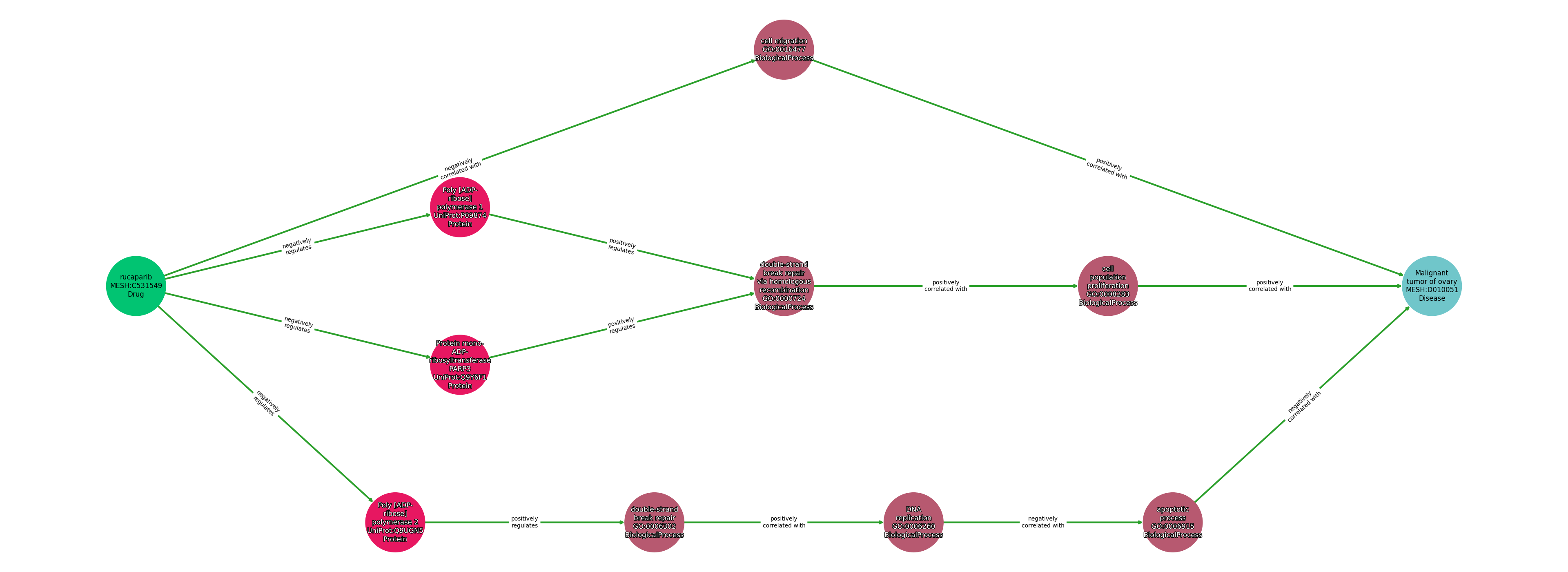Path ID: DB12332_MESH_D010051_1

Concepts
| Identifier | Name | Type |
|---|---|---|
| MESH:C531549 | rucaparib | Drug |
| UniProt:P09874 | Poly [ADP-ribose] polymerase 1 | Protein |
| UniProt:Q9Y6F1 | Protein mono-ADP-ribosyltransferase PARP3 | Protein |
| UniProt:Q9UGN5 | Poly [ADP-ribose] polymerase 2 | Protein |
| GO:0000724 | double-strand break repair via homologous recombination | BiologicalProcess |
| GO:0006302 | double-strand break repair | BiologicalProcess |
| GO:0006260 | DNA replication | BiologicalProcess |
| GO:0006915 | apoptotic process | BiologicalProcess |
| GO:0008283 | cell population proliferation | BiologicalProcess |
| GO:0016477 | cell migration | BiologicalProcess |
| MESH:D010051 | Malignant tumor of ovary | Disease |
Relationships
NOTE: predicates are annotated in Biolink Model (v1.3.0)
| Subject | Predicate | Object |
|---|---|---|
| Rucaparib | NEGATIVELY CORRELATED WITH | Cell Migration |
| Cell Migration | POSITIVELY CORRELATED WITH | Malignant Tumor Of Ovary |
| Rucaparib | NEGATIVELY REGULATES | Poly [Adp-Ribose] Polymerase 1 |
| Rucaparib | NEGATIVELY REGULATES | Protein Mono-Adp-Ribosyltransferase Parp3 |
| Rucaparib | NEGATIVELY REGULATES | Poly [Adp-Ribose] Polymerase 2 |
| Poly [Adp-Ribose] Polymerase 1 | POSITIVELY REGULATES | Double-Strand Break Repair Via Homologous Recombination |
| Protein Mono-Adp-Ribosyltransferase Parp3 | POSITIVELY REGULATES | Double-Strand Break Repair Via Homologous Recombination |
| Poly [Adp-Ribose] Polymerase 2 | POSITIVELY REGULATES | Double-Strand Break Repair |
| Double-Strand Break Repair Via Homologous Recombination | POSITIVELY CORRELATED WITH | Cell Population Proliferation |
| Double-Strand Break Repair | POSITIVELY CORRELATED WITH | Dna Replication |
| Dna Replication | NEGATIVELY CORRELATED WITH | Apoptotic Process |
| Apoptotic Process | NEGATIVELY CORRELATED WITH | Malignant Tumor Of Ovary |
| Cell Population Proliferation | POSITIVELY CORRELATED WITH | Malignant Tumor Of Ovary |
Comment: It is proposed that PARP inhibition specifically targets tumor cells with preexisting HRD (homologous recombination deficiency), such as those cells possessing mutations in the BRCA1 or BRCA2 genes (https://pubmed.ncbi.nlm.nih.gov/28790837/). This drug is a potent vasodilator and it’s believed that by dilating tumor-supplying vessels, tumor oxygenation will improve, which in turn it would improve radiotherapy, or increase anticancer drug delivery, as well as improve delivery of PARP inhibitor drugs (rucaparib and others) to the tumor, with consequent increased intra-tumoral PARP inhibition (https://pubmed.ncbi.nlm.nih.gov/25689628/).
Reference: